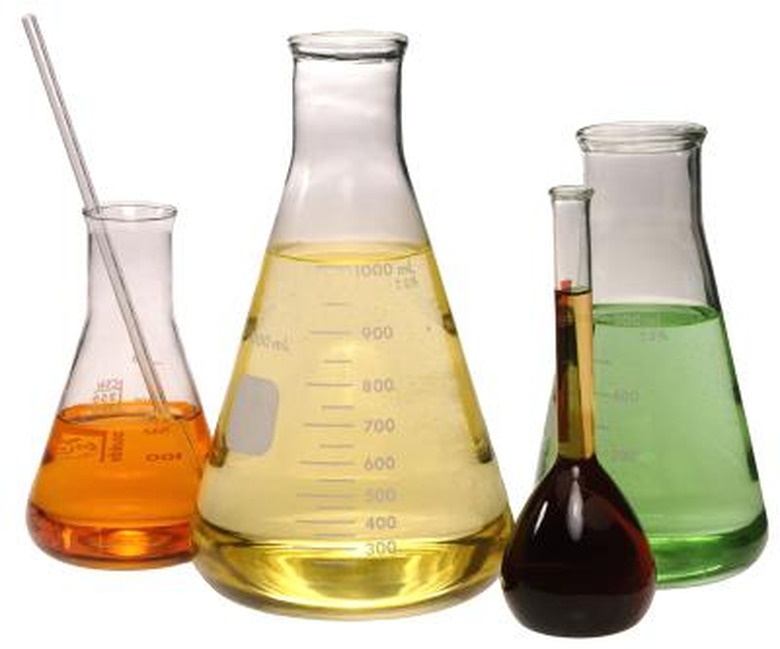How To Increase Molarity Of A Solution
A solution is a mixture of two parts: a solute and a solvent. The solute is the dissolved particle within the solution and the solvent is the part that dissolves the solute. For example, salt water is a solution composed of sodium chloride, the solute, dissolved in water, the solvent. Molarity is a measurement used to identify the amount of solute, in moles, dissolved in a solvent by volume and is expressed as moles per liter (mol/L). The molarity, therefore, is directly proportional to the amount of solute in solution and indirectly proportional to the volume of the solution. These two relationships can be used to determine how to increase the molarity of any solution.
Increasing the Molarity by Volume
Step 1
Determine the number of moles of solute in a given solution by dividing the number of grams of solute by its molecular mass. For example, a salt water solution containing 5 grams of sodium chloride would have 0.18 moles as determined by dividing the amount of solute, in grams, by its molecular mass ( 5 g / 28 g/mol = 0.18 mol of solute).
Step 2
Place the solution in a graduated beaker and identify the volume of the solution. Most beakers have measurements marked in milliliters. Since molarity is given in liters, the volume in milliliters must be converted to liters by multiplying by the conversion factor of 1 L / 1000 mL. Using the salt water example, a measured volume of 150 mL would be equivalent to 0.15 L using the conversion factor: 150 mL x (1 L / 1000 mL) = 0.15 L.
Step 3
Identify the molarity (M) of the solution based on the calculated moles of solute and observed volume in milliliters. The molarity of the saltwater solution would be 0.18 mol of solute per 0.15 L. or 1.2 M because 0.18 mol / 0.15 L =1.2 mol/L.
Step 4
Determine the change in volume required to increase the molarity to a specified value using the equation M1 x V1 = M2 x V2, where M1 and M2 are the initial and new molarities and V1 and V2 are the initial and final volumes, respectively. Doubling the molarity of the example saltwater solution from 1.2 to 2.4 would require a new volume of 0.08 L as determined by solving for V2 in the equation 1.2 M x 0.15 L = 2.4 M x V2.
Step 5
Make the new solution using the same amount of solute and newly calculated volume of solvent. The new saltwater solution would still contain 5 g of sodium chloride but only 0.075 L, or 75 mL, of water to result in a new solution with a molarity of 2.4. Therefore, a decrease in volume of a solution with the same amount of solute results in an increase in molarity.
Increase the Molarity by Solute
Step 1
Determine the molarity of a particular solution follwoing Steps 1 through 3 in the previous section.
Step 2
Identify the desired increase in molarity for the solution. For example, suppose an initial 1.2 M solution of saltwater needs to be increased to a 2.4 M solution with the same volume.
Step 3
Determine how much solute needs to be added to the solution to increase the molarity to the specified value. A 2.4 M solution would contain 2.4 moles per liter and the solution contains 0.15 L. The amount of solute, in moles, of the new solution is then identified by setting up a ratio given as 2.4 mol/ 1 L = x mol / 0.15 L and solving for the unknown x value. This calculation identifies a value of 0.36 mol of sodium chloride required for the new solution. Multiplying by the molecular mass of sodium chloride (28 g/mol) then gives the amount in grams of solute needed as 10.1 g.
Step 4
Subtract the initial amount of solute from the newly calculated amount to determine the amount of solute that needs to be added to increase the molarity. To increase a 1.2 M saltwater solution with 5 grams of sodium chloride to a 2.4 M solution requires the addition of 5.1 grams of sodium chloride as determined by subtracting the initial amount of 5 g from the newly required amount of 10.1 g. Therefore, adding 5.1 g of sodium chloride to a 1.2 M saltwater solution would increase the molarity to 2.4 M.
Things Needed
- Graduated beaker
- Periodic table
- Calculator
- Sodium chloride
- Water
References
Cite This Article
MLA
Perdue, Matthew. "How To Increase Molarity Of A Solution" sciencing.com, https://www.sciencing.com/increase-molarity-solution-8451816/. 24 April 2017.
APA
Perdue, Matthew. (2017, April 24). How To Increase Molarity Of A Solution. sciencing.com. Retrieved from https://www.sciencing.com/increase-molarity-solution-8451816/
Chicago
Perdue, Matthew. How To Increase Molarity Of A Solution last modified March 24, 2022. https://www.sciencing.com/increase-molarity-solution-8451816/
